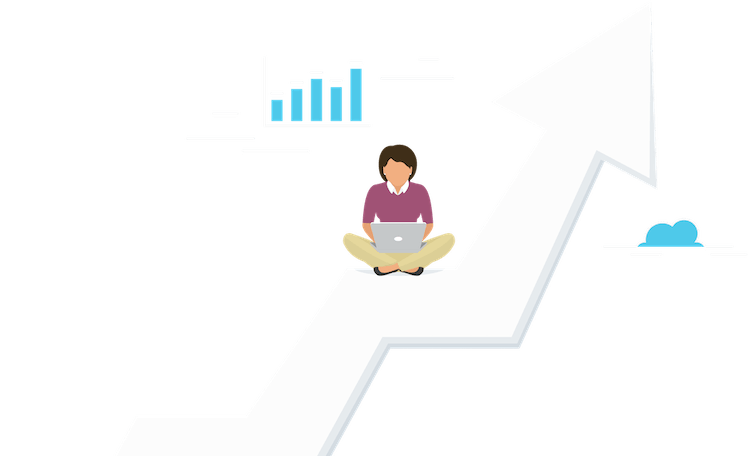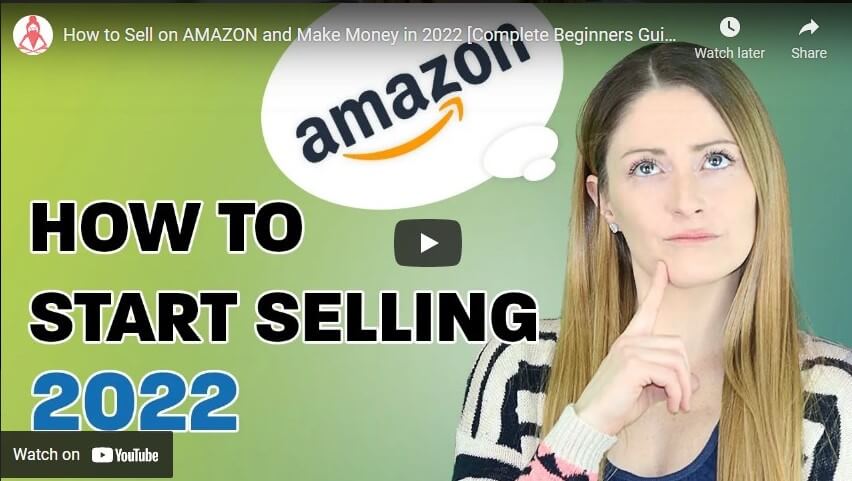How to Sell on Amazon: The Beginner’s Guide for 2021

Trifon Tsevtkov
May 10, 2019
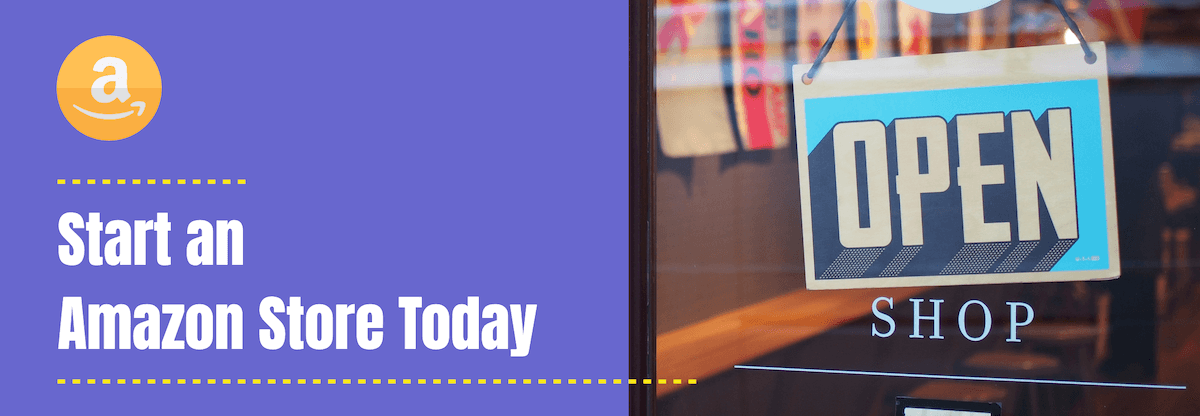
Okay, so you've pondered the idea for a while - starting an Amazon store from scratch and turning it into a successful venture. And now you're ready to take the next step. Only it's not clear what that step should be. All the crazy Amazon success stories start with the zillions you can make but often skip the specifics until you open up your wallet and buy a course or two. Don't worry - this is why we created this guide. Here, you'll find all the key information you should know before starting your first Amazon store - without spending a dime.
We'll cover everything from the basic lingo and terminology you should be aware of to the most important product sourcing and fulfilment methods. We'll also look into key concepts in Amazon sales such as securing the Buy Box and using the Best Seller rank to your advantage when choosing products. By the end of this guide, you should go from complete beginner to navigating the world of Amazon sales with confidence.
Ready? Let's go.
Your Mindset - the first step to Amazon success
Before we go any further we would like to spend a little time on the subject of mindset in relation to starting up and running a store on Amazon.
This is a real business which can reward your hard work in ways like few other online ventures are able to.
It’s important you realize that during the early stages of your business you may only be making a small profit or breaking even. However, your Amazon account will be maturing and you will be learning invaluable lessons.
There may be times when it seems that you are not progressing as fast as you like and this is when you will be susceptible to “shiny object syndrome”. An email from an internet marketing guru may land in your inbox promising to show you how to earn a fantastic living by using various internet marketing techniques.
You may be tempted to take a look at these other opportunities, but we urge you to follow one course until successful.
These are exciting times in which we are living and this opportunity can provide you with the kind of lifestyle that you may have previously only dreamt about.
Remember one thing - if you think you can achieve success with it, you probably can!
Lingo and terminology you should know about
We will be using basic lingo and terminology throughout this post in relation to selling on Amazon and you’re likely to find these terms elsewhere. This is why we thought it would be a good idea to list some of them below in case you are unsure of the meanings.
Profit Margin
The profit margin is a profitability ratio and expressed as a percentage. Take this for example:
| Title | Formula | Sample Amount |
|---|---|---|
| Total Revenue | $1,000 | |
| Cost of Goods Sold | $400 | |
| Amazon Fees | $300 | |
| Net Income | Total Revenue - Cost of Goods Sold - Amazon Fees | $300 |
| Profit Margin | Net Income / Total Revenue | 30% * |
* It means that you make 30% profit on your revenue.
ROI
Return on Investment is another type of profitability measure. For example:
| Title | Formula | Sample Amount |
|---|---|---|
| Net Income (Profit) | $300 | |
| Investment/Money Spent (Cost of Goods Sold) | $400 | |
| ROI | (Income / Investment) X 100 | 75% * |
* This means that you make a 75% return on your investment.
ASIN
Amazon Standard Identification Number (a code which identifies a product on Amazon).
UPC
Universal Product Code which consists of 12 numeric digits that are uniquely assigned to each item in the form of a barcode.
FEIN or EIN
Federal Employer Identification Number (suppliers may ask for this to prove your identity).
Resale Certificate
This is a certificate that is issued by the state you do business in which shows your retailer status, also known as, ‘tax exempt form’.
Minimum Advertised Price (MAP)
The lowest price a supplier or brand owner will allow you to sell a particular product.
Manufacturer's Suggested Retail Price (MSRP)
The price at which the manufacturer recommends that you sell a product.
Quarter
This is the period of three months, expressed as 'Q' and a number. For example, Q4 on an annual calendar is from October through December. Depending on the products you sell, there is usually a massive peak in sales during Q4.
Minimum Order Quantity (MOQ)
Your supplier will often have a MOQ in place which is the minimum amount of product you can purchase in one order.
Wholesale Price
The product price which you pay to your supplier.
NET 15 / NET 30 / NET 60
When establishing credit terms with a supplier, they will typically offer a grace period for how long you can take to make a payment. The number after NET represents the number of days you have to make a payment of the net balance. So, NET 15 = 15 days, NET 30 = 30 days, etc.
Amazon fulfilment methods - FBA vs FBM
The first decision you will be faced with when running your Amazon business is to decide if you will arrange the delivery of orders yourself or get Amazon to deliver for you.
This is known as Fulfilled by Merchant (FBM) or Fulfilled by Amazon (FBA).
Different sellers have different views on which method is best, but before we share our views with you it might be a good idea to briefly talk about each one.
Fulfilled by Merchant (FBM)
In FBM, the seller is responsible for shipping products from their own home or business premises when they have been informed by Amazon that a sale has been made.
It goes without saying that this means the seller has to pack the order, make arrangements for shipping, and be responsible for the customer service in relation to the order. The cost of storing the products should also be taken into account as warehouse costs can soon mount up.
Fulfilled by Amazon (FBA)
In FBA, the seller sends their stock to an Amazon Fulfillment Center and Amazon basically takes care of everything from there. When an order is placed, an Amazon employee will pick the product from the storage so it can be packed and shipped using Amazon’s trusted shipping partners.
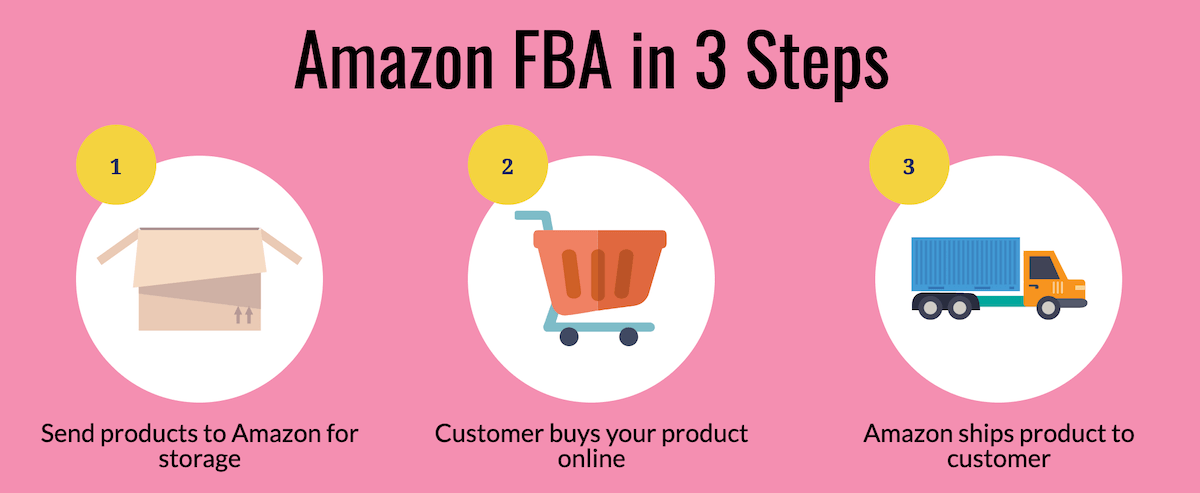
Amazon will also provide customer service in relation to the products which are sold through the FBA program. This service obviously does not come without charges and this is the main reason why some sellers choose FBM over FBA.
Our Advice
We have used both methods, and can honestly say that FBA would be our number one choice every time. The big difference for us is that when you sell through FBA, you get access to Amazon shoppers who have Prime accounts which is a massive plus.
Nowadays, online shoppers require delivery as soon as possible and Prime customers get 1-3-day free delivery. Also, with FBM, don't underestimate the time it can take to fulfill the orders yourself. Not to mention, the time it takes handling returns and having to provide customer service. These tasks are all time consuming and, in some cases, extremely stressful.
In addition, any negative feedback on FBA orders (not product reviews) can be removed. Also, it is often the case that FBM sellers pay higher costs to UPS for delivery compared to the fees charged by Amazon for their fulfillment services.
If you want to make the most out of the information to follow, we would strongly recommend that you go down the route of FBA.
After you decide on a fulfillment method, it’s time to look at product sourcing.
The most common product sourcing methods on Amazon
There are several different methods for sourcing products to sell on Amazon with each one having its own advantages and disadvantages.
We realize that it can be difficult for the new Amazon seller to decide on which method to go with. It gets even worse when the so-called gurus bring out course after course on retail arbitrage techniques and white label methods which proclaim to make anyone who purchases their courses an Amazon a millionaire overnight!
Before we go any further, it would be a good idea to review the most popular sourcing methods so that you can see what they are all about.
Arbitrage
The word arbitrage originated in the financial markets. Arbitrage opportunities occur when there are an almost simultaneous purchase and sale of an asset which results in a profit from the difference in price.
The term has been picked up by the marketing gurus and has been applied to all sorts of marketing techniques. But in other words, it is just buying something in one marketplace and selling it in another at a higher price to generate a profit.
When it comes to using arbitrage with Amazon, there are two types - online arbitrage and retail (offline) arbitrage. Let’s take a look at the latter first.
Retail Arbitrage
If you have ever seen someone scanning barcodes in your local Walmart, the chances are that they are involved in some form of retail arbitrage.
Retail arbitrageurs usually download software onto their smartphones. When they scan the barcode of a product, the software will tell them if there is a profit to be made online. They purchase the product at that lower price and then resell on Amazon at a higher price.
This method usually appeals to the newbie Amazon seller because it allows them to start selling online with minimal costs.
As you can probably imagine, there are downsides to this method of selling. With that in mind, let’s take a look at the pros and cons.
Pros:
-
Low startup costs.
-
At times you can find products that are cheaper than wholesale.
-
Possible to take advantage of cashback and credit card incentives.
-
A lot of opportunities in Q4 (October - December) because of the offers which are available to entice shoppers into buying Christmas presents and there is also a demand for them on Amazon.
Cons:
-
Many stores do not like retail arbitrageurs and you could be asked to leave.
-
It is very difficult to scale up. If you find a product that offers a decent profit there may not be many available, and you could be limited to how many you are allowed to purchase. Extra costs, such as driving to the locations and time spent scanning can mount up. Overall, this may have a detrimental effect on any profits.
-
The internet connection can be poor in some stores which will cause problems for identifying profitable opportunities.
Online Arbitrage
For those who are interested in retail arbitrage but don’t like the idea of everything that is involved, online arbitrage could be the answer. Instead of trawling around shopping malls, you search for arbitrage opportunities that are available online.
Pros:
-
Coupons and discount codes can be used to bring the price of a product down which will increase the profit potential.
-
There are software tools available which automate the process of searching for arbitrage opportunities.
Cons:
-
As with retail arbitrage, this method is extremely difficult to scale.
-
Prices can change quickly and can leave the Amazon seller with stock which can only be sold at a loss.
-
If a claim is made that the product is a fake, it can be difficult to prove otherwise.
-
As you will be dealing with a single or small number of products, the shipping and prep costs can be expensive.
-
It is easy to underestimate the time cost and the result is that many online and offline arbitrage sellers are making far less profit than they think they are.
Drop Shipping
From time to time on online seller forums, you may read about sellers using various forms of drop shipping with Amazon and making a decent profit from it.
If you are not familiar with drop shipping, it is when you advertise a product for sale on Amazon but you don't hold any stock for that product. When you receive notification that a sale has been made, you notify either the manufacturer or wholesaler and they will then ship the product directly to the customer.
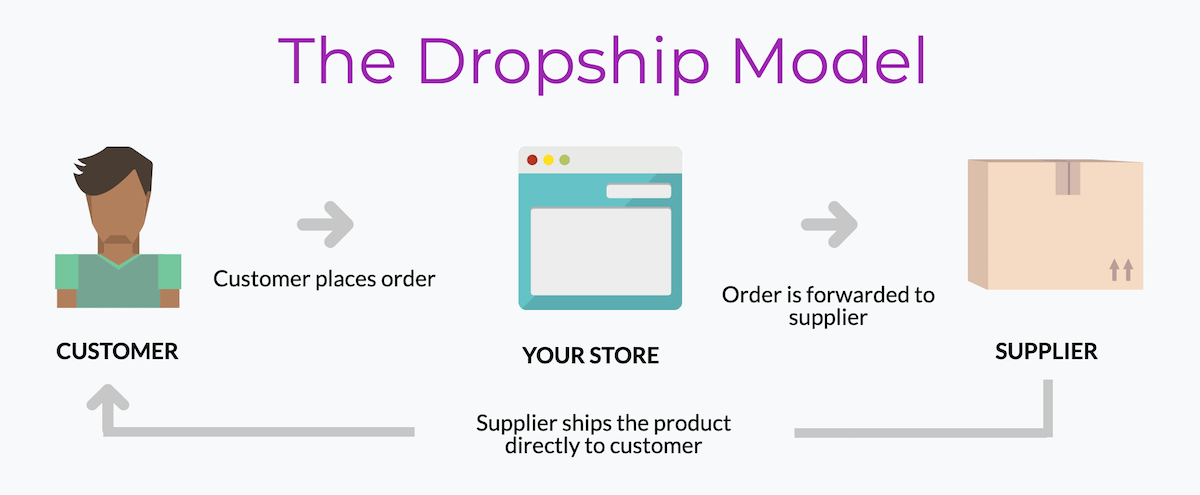
Our advice would be that if you really want to get into drop shipping, don’t even consider Amazon as the sales platform to use.
However, it sounds like an attractive proposition, especially for the seller who has limited funds to invest in stock. So, let’s take a look at the pros and cons of drop shipping with Amazon.
Pros:
-
No funds required for stock. You pay the supplier out of the money you have received from the sale.
Cons:
-
If there is a problem with the order it is up to the seller to sort it out, and if the supplier does not respond in a timely manner, it can cause big problems with Amazon.
-
The cost will be higher than buying wholesale, which means that there is very little room for profit.
-
Low entry cost leads to a lot of competition, which means Amazon listings get too crowded and prices drop to unprofitable levels.
Private Label
The simple explanation for Private Label is when you purchase an unbranded product and put your own brand on it. It all sounds very simple, but the process often involves investing large amounts of money with companies in countries like China, and due to language and culture differences it can prove to be very difficult.
Let’s take a look at the pros and cons of the Private Label sourcing method.
Pros:
-
Get it right and the profits can be substantial.
-
As it is your product, you can control the distribution.
-
Easy to scale.
-
Opportunities to sell offline as well as on Amazon.
-
You will be able to add more products to the same brand.
-
If successful, the brand can become a profitable asset further down the line.
Cons:
-
Initial financial outlay can be far greater than any of the other methods.
-
Money has to be spent on marketing if the brand is new.
-
As the brand owner, you will be liable should there be any problems in terms of health and safety.
-
Trademark and patent laws will need to be investigated thoroughly.
-
Can be difficult to sell a brand that nobody has heard of.
-
If working with a manufacturer you are not familiar with, it can take months between initial contact to the point where the product is ready to market.
Liquidation Sourcing Method
Liquidation or closeout sales are when a company is either closing down and selling off their stock or a company is selling off stock in order to raise capital.
You no doubt have seen examples where a retailer or wholesaler is closing down and as a result, the stock is being sold off at a fraction of the retail price.
Nowadays, these types of sales are occurring more often than you probably imagine and the potential to make profits from these sales is enormous.
Let’s have a look at the pros and cons of this sourcing method.
Pros:
-
High-profit margins.
-
Possible to find products which are in high demand but have low competition.
Cons:
-
If there are any complaints regarding authenticity, it can be very difficult to prove otherwise.
-
The products which you order may be damaged.
-
Unless you are familiar with the source, there is the possibility of the goods being counterfeit.
-
Hard to scale as you will be buying different products all the time.
Wholesale
Wholesale sourcing is when you purchase branded stock in bulk at a lower cost and resell it at a higher price on Amazon.
This is the method we use because it ticks so many of the boxes when it comes to product sourcing and we know first-hand just how profitable it can be.
When the wholesale sourcing model is carried out properly, you can be up and running in under 10 days, selling products that are proven to sell. Even in the worst-case scenario, if the price drops, you will only incur a small loss but more than likely you will get all of your money back.
The icing on the cake for us is that you can sell hundreds or thousands of different products so that all of your eggs are not in one basket.
Let’s have a look at the pros and cons of the wholesale sourcing method.
Pros:
-
Be up and running in under 10 days.
-
The ability to sell products that are already proven sellers.
-
A very small risk to the invested capital.
-
Easy to forecast exactly what the potential profits will be.
-
Very easy to prepare for FBA.
-
Once you have built up a history with your supplier, it is often possible to arrange a credit line with them which will enable leverage of products for sale.
-
Possible to develop relationships with brand owners which will, in turn, eliminate competition.
Cons:
-
Some brands will not allow the sale of their products on Amazon.
-
If you are making a decent profit, you will be on Amazon’s radar and they may attempt to approach your supplier with a view to cutting you out of the deal.
-
Profit margins can be smaller but that is more than made up for by the volume of products that can be sold using this method.
Ok, so now we’ve had a look at the different fulfillment and sourcing methods. Once you choose which ones are best for you, it’s time to consider the selling fees involved.
Amazon FBA fees to consider before starting your store
While learning how to sell products on Amazon, you will obviously notice that there are fees involved with selling on Amazon. So it is important to take these fees into account when calculating potential profit margins.
To begin with, there is a choice of two selling plans for Amazon:
-
Professional Selling Plan: $39.99 per month.
-
Individual Selling Plan: No subscription fee.
The main difference between these two plans is that with the individual selling plan, a fee of $0.99 is payable to Amazon for each product that is sold. With the professional selling plan, there is no per item fee.
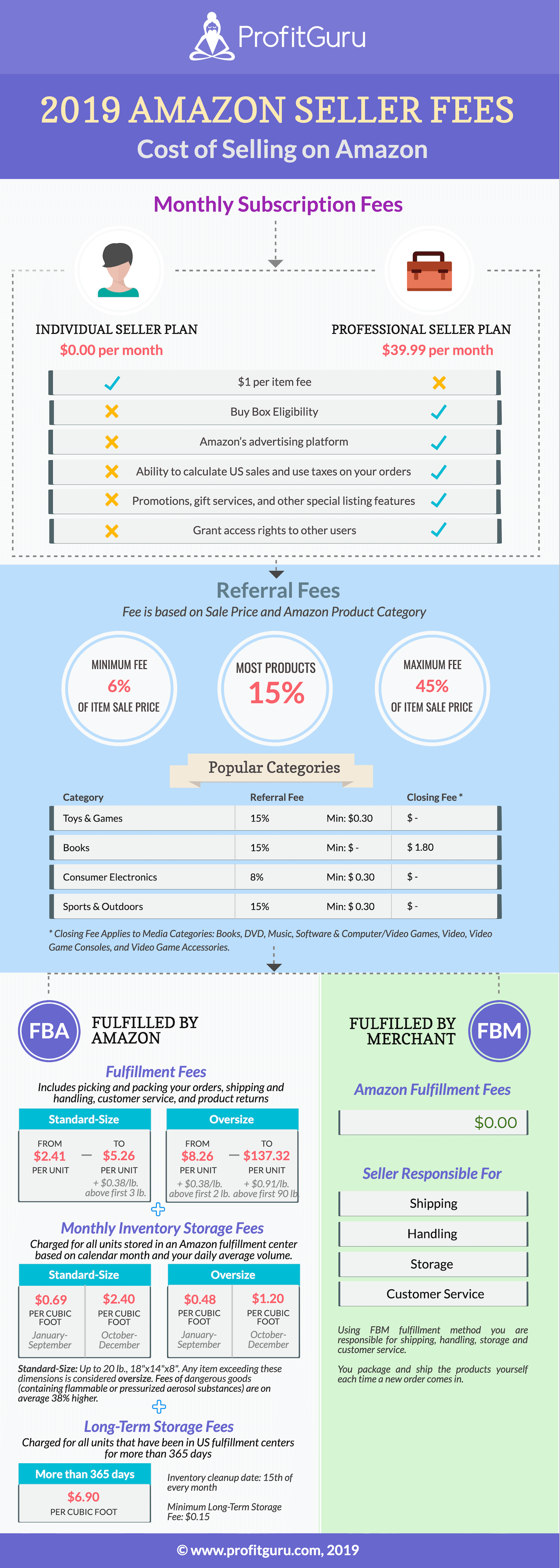
We would strongly advise that you start off with the Professional Selling Plan as this is a requirement before you join the FBA program.
The next set of fees to take into consideration are the Referral Fees. Amazon sellers have to pay a referral fee on each item which is sold. These referral fees vary depending on the category they fall in.
You can see a breakdown of the Amazon fees per category on the official Amazon fee schedule.
Now, let’s go on to the other types of fees you should consider.
FBA Fees
There are two types of fees with the Fulfilment by Amazon program. They are the Fulfillment Fee and the Monthly Inventory Storage fee.
Fulfillment Fees
When one of your items is sold through the FBA program, Amazon’s members of staff have to pick it from storage, pack the order and ship it to your customer.
They also handle customer service, as well as any returns. The total Fulfillment Fees depend on the size of the item and you should regularly check the fees as they are prone to change.
You can see up-to-date fulfillment fees on the Amazon pricing page for sellers.
Monthly Inventory Storage Fees
On top of those fees, there is also a Monthly Inventory Storage fee which is priced per cubic foot.
As these fees are fixed, it makes it easier to calculate the profit margins when deciding to purchase stock to send to Amazon.
You should always check with the Amazon FBA calculator before buying/shipping and it will show exact numbers for a particular item. Here’s how to do that:
-
Go to the FBA Revenue Calculator and find the product by ASIN.
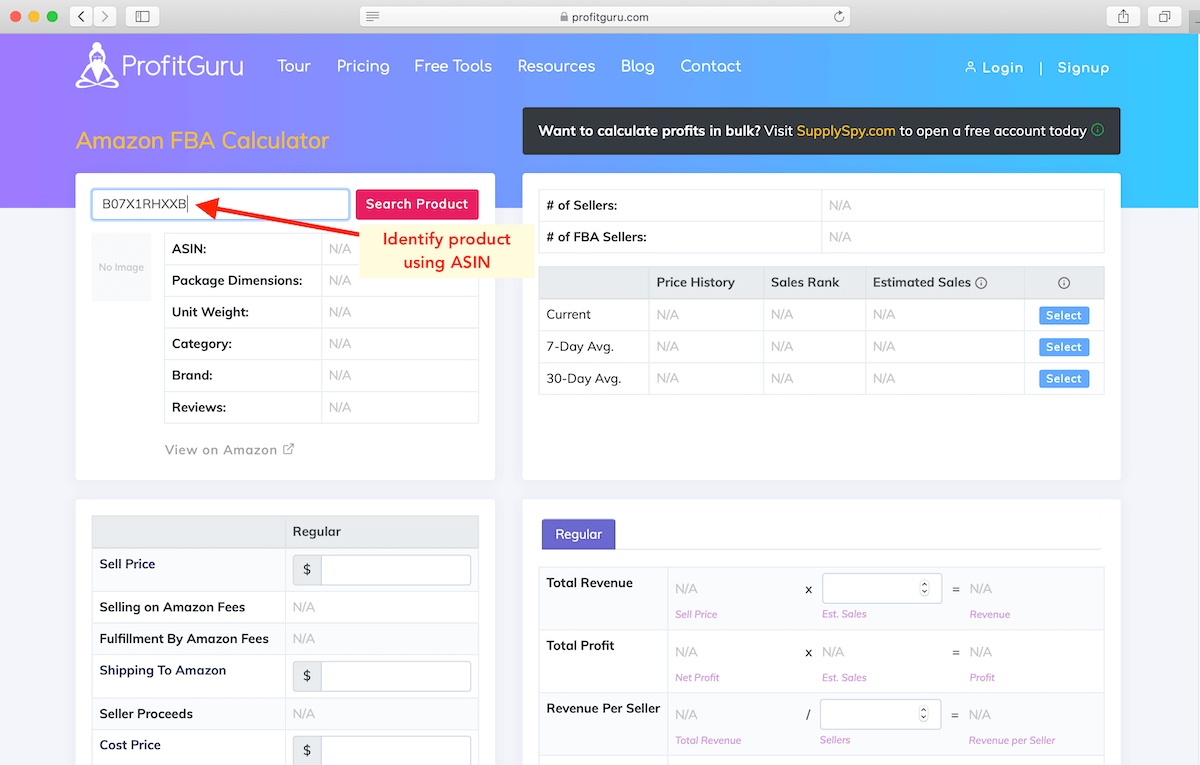
Amazon profit calculator - identify product by ASIN. (Amazon Standard Identification Numbers (ASINs) are unique blocks of 10 letters and/or numbers that identify items. You can find the ASIN on the item's product information page at Amazon.com).
-
Next, specify your projected selling price.
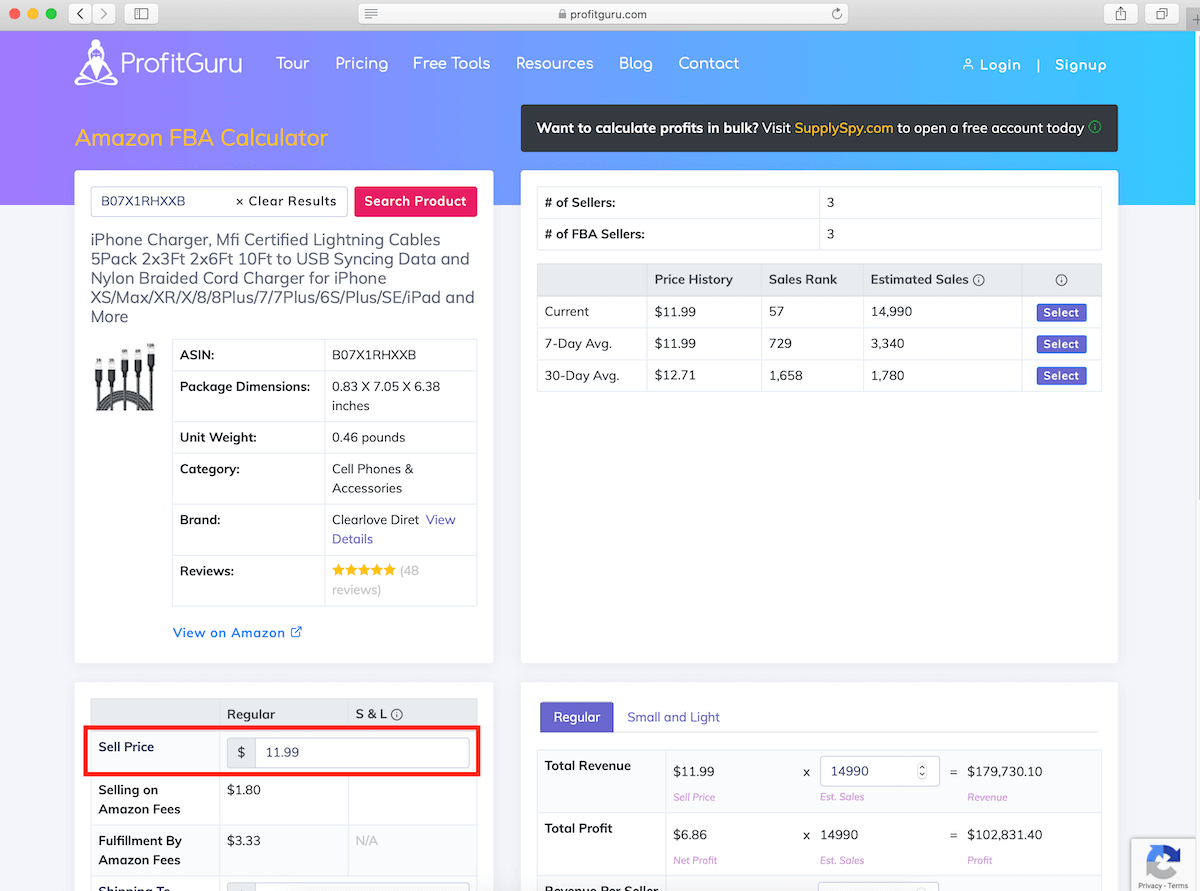
Amazon profit calculator - enter the sales price
-
This will show you all the Amazon selling costs, Net Profit, Net Margin, ROI and number of potential sales per month for FBA fulfillment method.
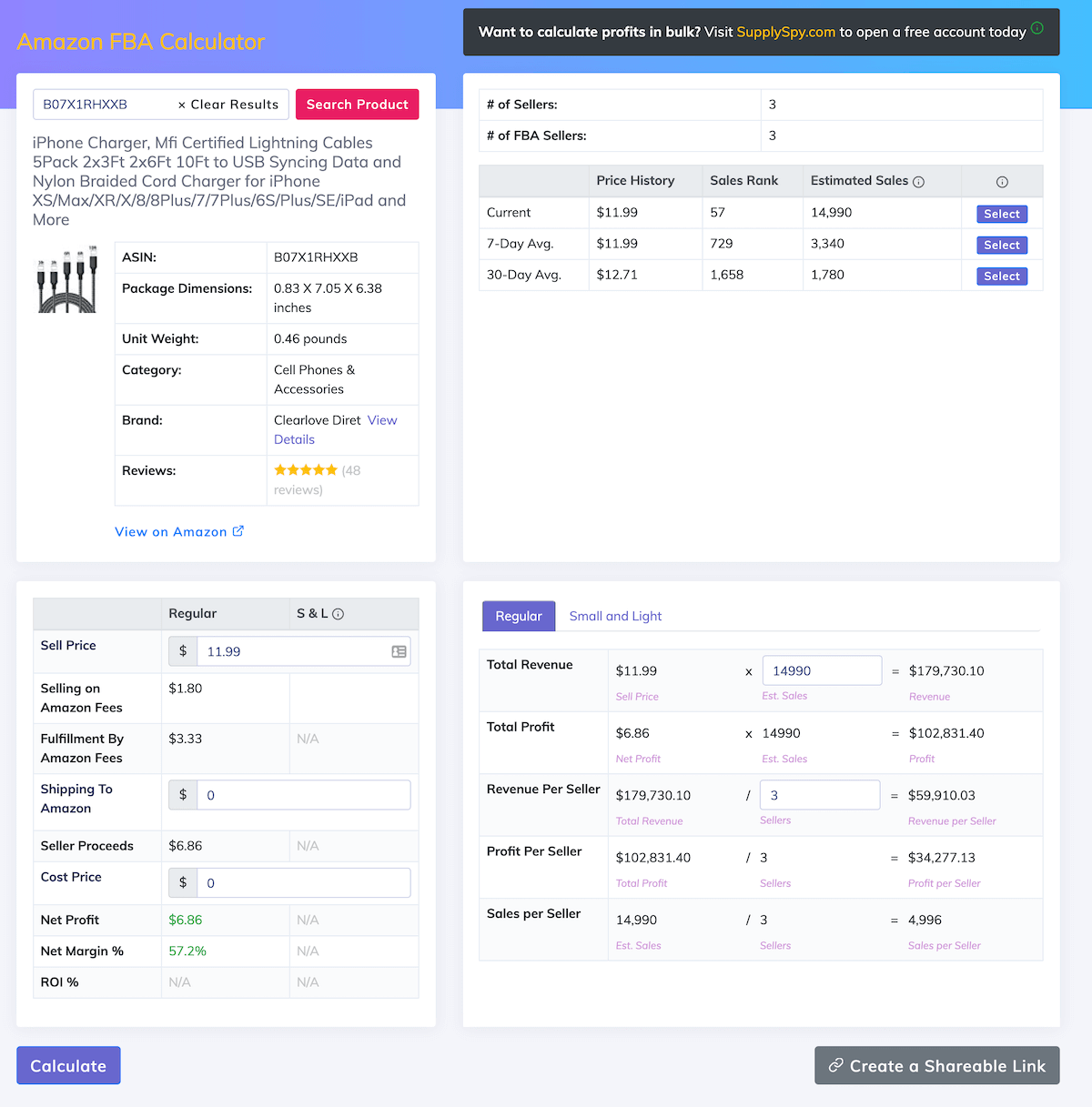
Amazon product calculator product details
Admittedly, it all sounds very confusing and also very expensive but please believe us when we say that it is worth it.
Our advice beginner sellers would be to start off with small and lightweight products. The fulfillment charges are lower and offer a huge advantage over large items when it comes to the storage fees. Storage fees can soon mount up if you have a few large items that are slow sellers.
Okay, so now that you have a good idea about the Amazon FBA fees and how they are calculated, it’s time to choose your first products to sell. Let’s continue.
How to use the Best Sellers Rank to your advantage when choosing products
When you are going through the research process and which products to sell on Amazon, wouldn’t it be great if you could get an idea of how many of those products are actually selling at the moment?
Well, this is where the Amazon Best Sellers Rank comes in. Even though it doesn’t give you the exact figure, it gives an estimation which can serve as a very good guide.
The Best Sellers Rank can normally be found towards the bottom of the product detail page. The best way to describe this rank is that it is a product’s current sales volume when compared to the sales volume of other products in the same category.
A point of confusion for many people is if a higher or lower number relates to the better sales rank. To answer that question: the lower the sales rank the more popular the product is.
The Amazon Best Sellers Rank below is for the ‘Transformers: The Last Knight Premier Edition Deluxe Bumblebee’ product.
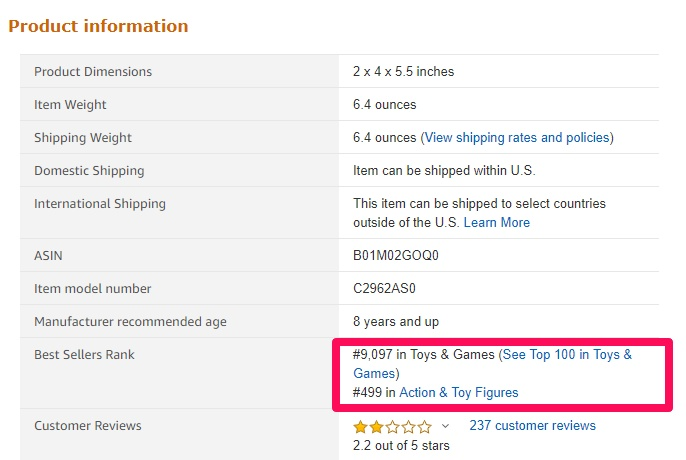
Amazon product information
It is quite common for a product to have a Best Sellers Rank in more than one category, so in the example above the product is ranked 5,931 in 'Toys & Games', and 348 in 'Toys & Games > Action & Toy Figures’.
It is important to note that only the Best Sellers Rank in the root category is what you should be paying attention to because no one has any data on how popular subcategories are.
You may be thinking to yourself it is all well good to know the Best Sellers Rank of a particular product, but what does that actually mean in terms of sales figures?
Enter ProfitGuru
ProfitGuru is a tool which you can use to give you a rough estimate on how many sales a particular product makes in a month according to its Amazon Sellers Rank.
Again, using the example of the ‘Transformers: The Last Knight Premier Edition Deluxe Bumblebee’ and it’s Amazon Sellers Rank, it is just a case of entering the ASIN and then clicking the Search button.
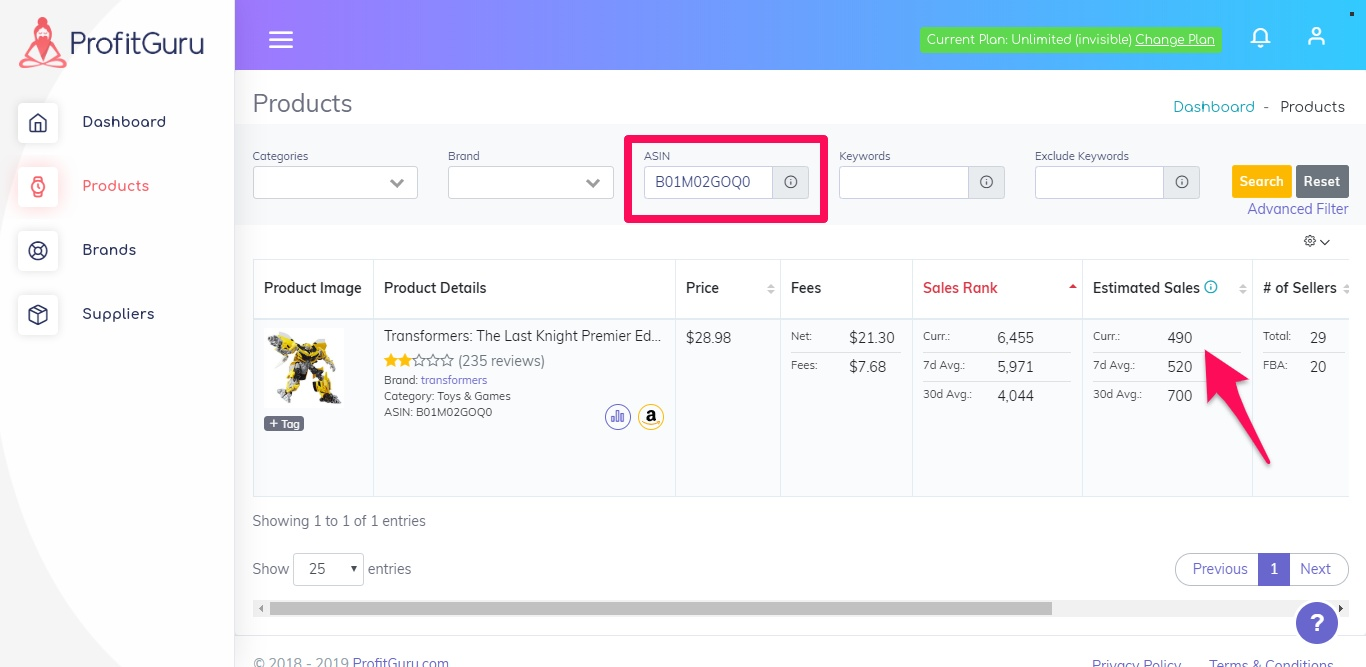
Profitguru estimated product sales
You can see that the estimated sales per month of this product are 570.
Why the Best Sellers Rank might not be all that it seems
If you look a little deeper in the Amazon Best Sellers Rank you will discover that the figure is actually a snapshot of how a product is selling at that particular time.
For obvious reasons, this could be extremely misleading. There could have been a spike in sales if a particular product was popular on Mother’s Day, for instance, but for the rest of the year, sales could be a lot lower.
Before you make an investment in stock, it is important that you take a broader view of how a product sells throughout the year.
This is why ProfitGuru also gives you a 7-day and 30-day average estimate in addition to the current sales estimate.
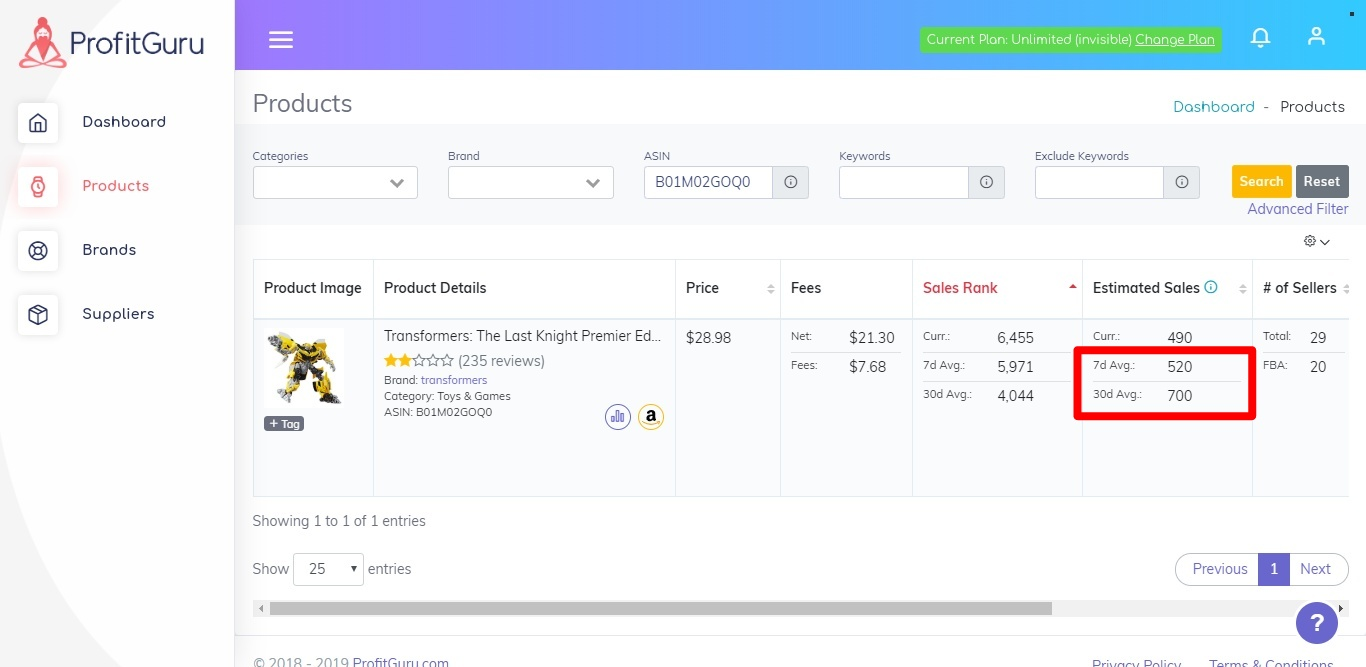
Profitguru product sales estimator - 7-day and 30-day average estimates
If you’d like to get a more detailed view of the historical sales rank, you can click on the Stats icon next to the product name:
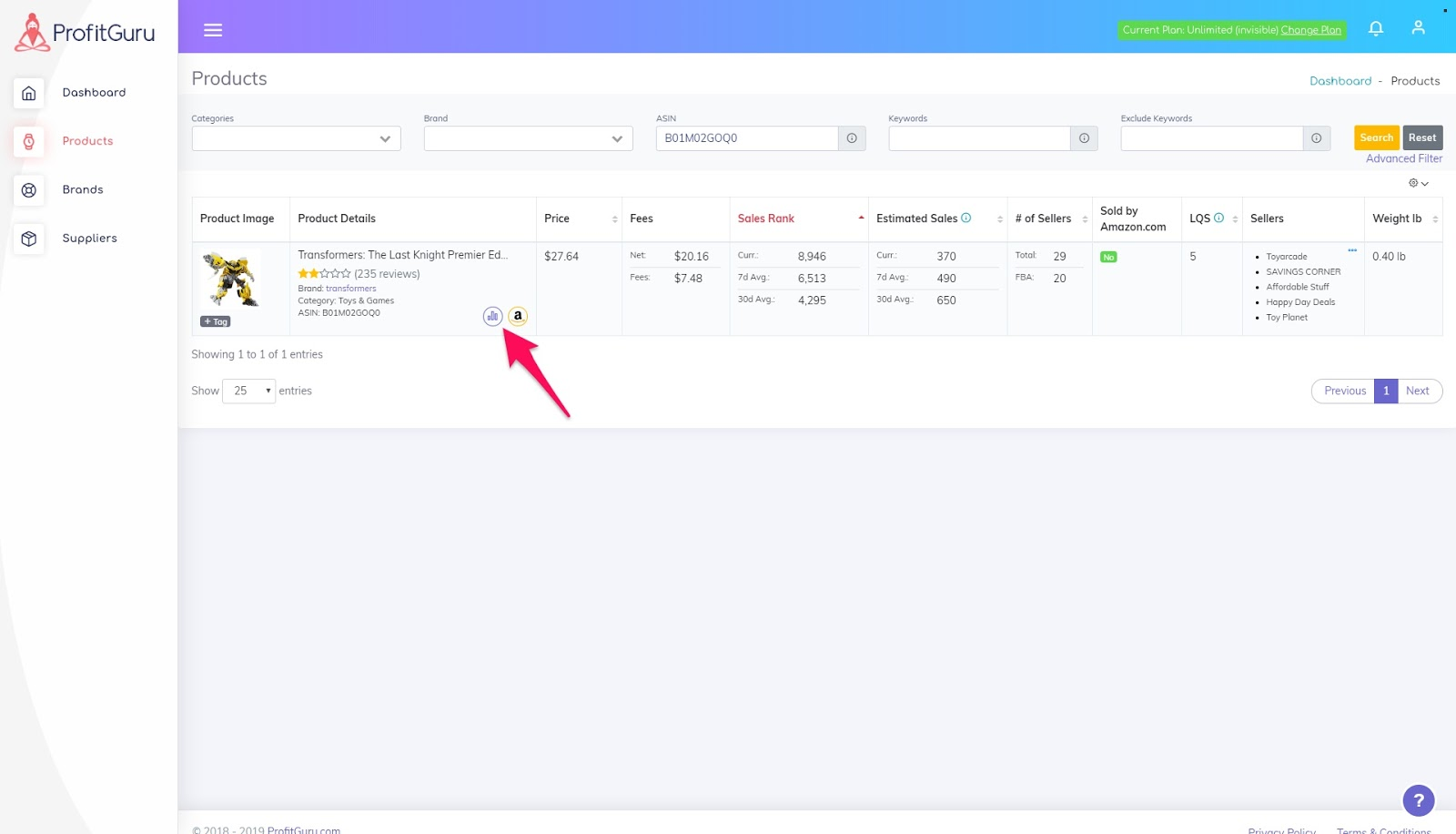
Profitguru historical product data
This will pull out key information about the product’s historical price, number of sellers and sales rank:
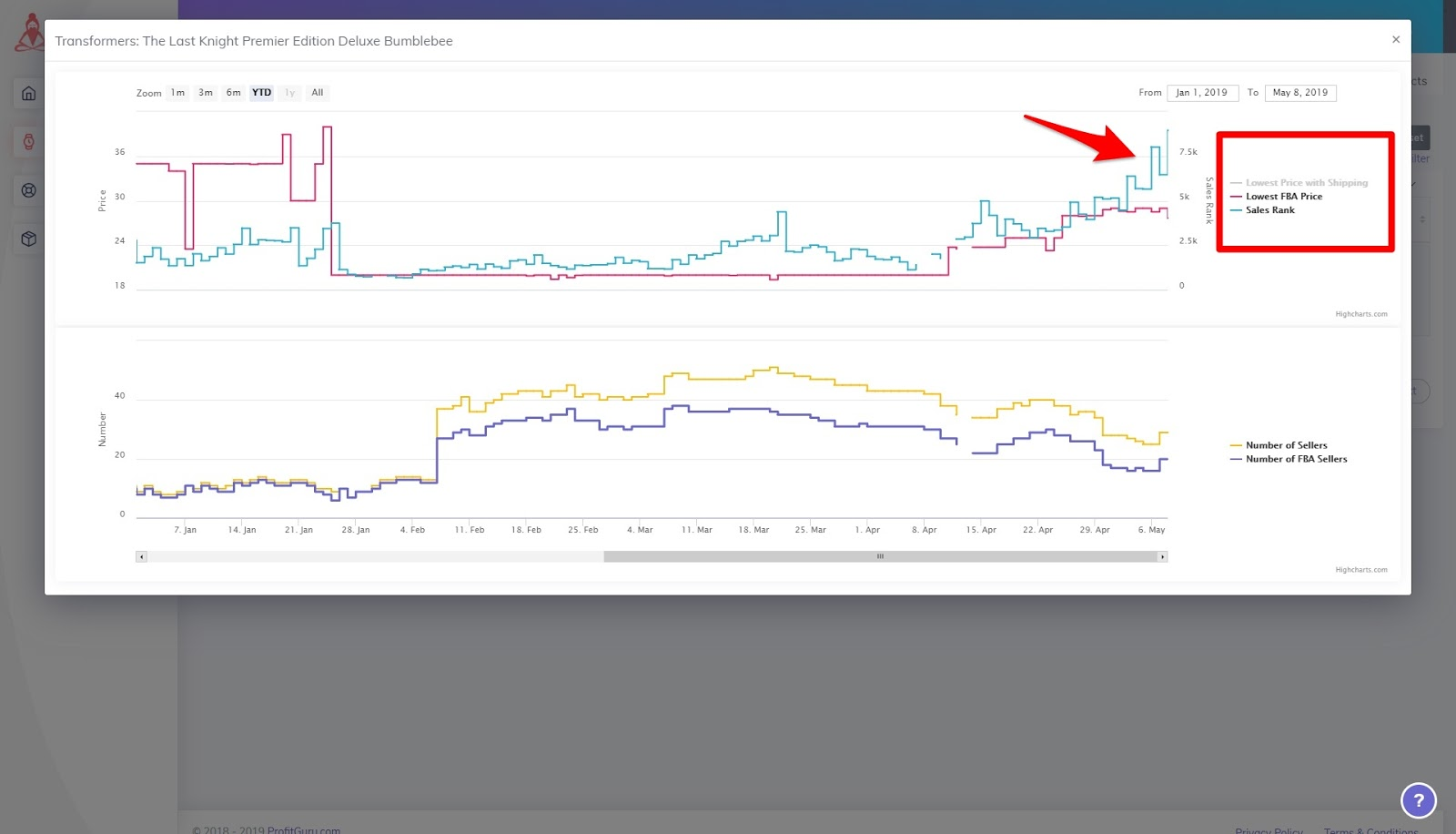
Profitguru product stats
We can see the product’s sales rank is going up, meaning the sales volume is going down relative to other products in the same category.
This way, you will know how the item is selling over time and avoid products that are likely to pile up and influence your FBA storage costs.
In this particular case, it seems like the product sales are reducing, probably due to the low product rating.
The Amazon Buy Box - why it’s important and how to secure it
Before we wrap up, it’s time to look at one last crucial element for Amazon sales success - the Buy Box.
Some people find the whole Buy Box thing to be a little confusing and that is why we’ll explain it here. All it really boils down to is as follows:
In theory, there is only one product page for each product which is for sale on Amazon, so all the sellers who are selling that particular product have to compete for that listing.
When you compare this system with eBay, a seller creates their own product listing. If another seller sells the same product, then they must create a separate listing.
There are then two listings for the same product, which are completely different.
In contrast, look at this Amazon listing:
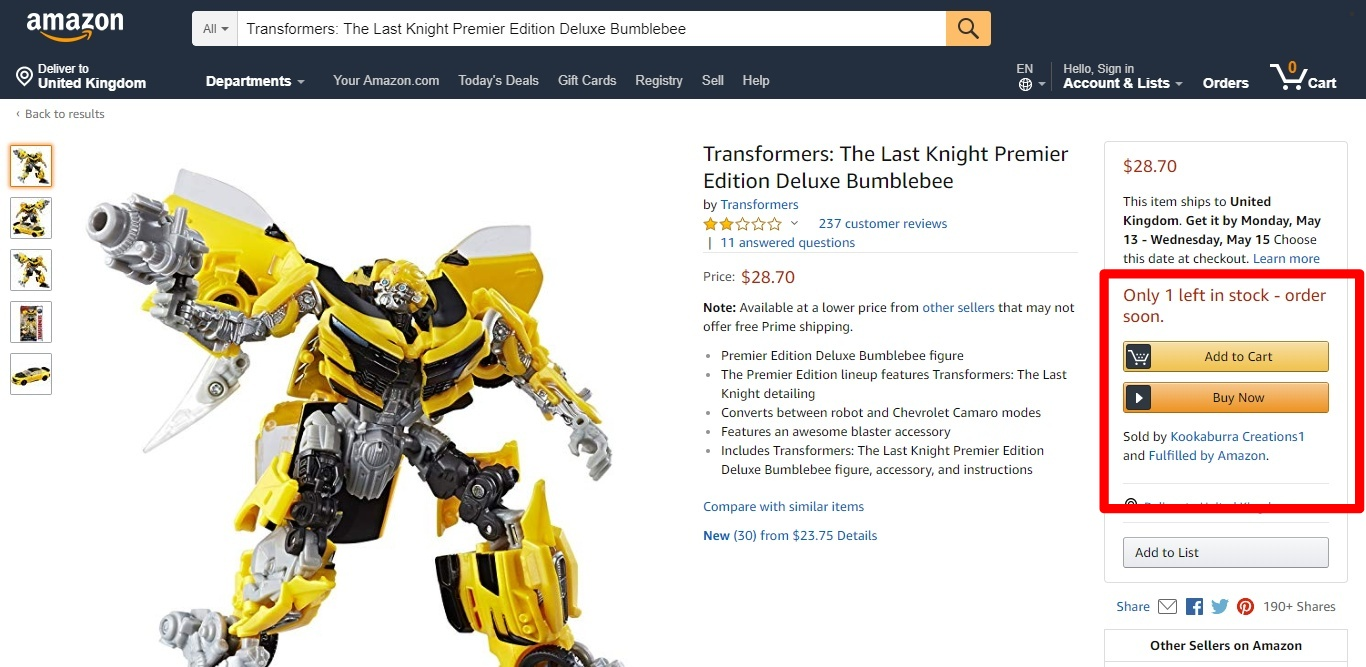
Amazon product buy box
To the right of the product description, you will see the Buy Box which contains the ‘Add to Cart’ button.
When someone clicks the ‘Add to Cart’ button to make a purchase, they will be purchasing from the seller who has the Buy Box.
The only way that this product can be purchased from any of the other sellers is by clicking on the link underneath the description where in this case it says ‘New (30)’.
These other sellers have to compete with the seller who has the Buy Box so the benefits of being the seller who has the Buy Box are obvious.
Always remember that the customer will choose the easiest option when making a purchase.
How do you win the Buy Box?
This is a question that has no definite answer because the algorithm which Amazon uses to decide who gets the Buy Box is a secret known only to them!
If you take the time to study a number of Amazon listings though, you will see that most listings that win the Buy Box have the same things in common. Here they are:
Pricing
In our example of Amazon listing, ‘Transformers: The Last Knight Premier Edition Deluxe Bumblebee’, the Buy Box price is $28.70, but if you click on the link to view the other sellers the average price is around $45.
Whilst the Buy Box price is not always the cheapest available, it is usually at the bottom end of the pricing scale.
Also, when a seller is using FBA, Amazon has far more control over the customer experience in that they control the shipping, the customer service and everything in-between.
It, therefore, makes sense that in most cases they will favor a product which is fulfilled by Amazon in the Buy Box as opposed to fulfilled by the merchant.
The state of the seller’s account
The advantages of using FBA are evident when investigating the state of a seller’s account, which is also thought to be a factor in getting the Buy Box.
If you are not familiar, ODR is the key measure of a seller’s ability to provide a good customer experience. It's the number of orders with a defect divided by the number of orders in the relevant time period. An order has a defect if it earns negative feedback, an A-to-Z Guarantee claim that is not denied, or a service credit card chargeback.
A poor record of shipping performance and Order Defect Rate (ODR) will decrease your chances of winning the Buy Box, but both are virtually eliminated when using FBA.
This contributes to a factor thought to influence the Buy Box of having a high customer feedback percentage. As long as any poor feedback is down to fulfillment or customer service, these will be removed if using FBA.
At the end of the day, if you put customer service as a top priority you will be on the right track in keeping your seller account at a high level.
Stock availability
It is as simple as this: if you are out of stock, you can’t win the Buy Box. Always think ahead and take measures to replace stock when it is running low.
It is easy to get caught up with all of this talk about how to win the Buy Box, but when you think about it, common sense prevails.
If you are offering products for sale through FBA, as long as they are priced competitively and your customer service is top notch, you will be on the right track to win the Buy Box.
You will see instances where a seller has won the Buy Box, but they don’t seem to tick any of the boxes that you would normally expect them to. This might happen from time to time, but don’t let it worry you. Over the long term, a seller who meets the criteria we have just mentioned will stand a far better chance of winning the Buy Box.
It should also be mentioned that if several different sellers are equal, have the same low price as well as the same seller ratings, they can all share the Buy Box and ultimately the profits that go with it.
Conclusion
Well, that was a long post, wasn’t it?
There’s a lot to know before you start selling on Amazon and we hope this guide has given you everything you need to make the next step.
If something sticks after reading all that, we hope it’s this: selling on Amazon is rewarding but it’s also tough. You need to approach it with a long-term mindset and ignore all the hype about becoming a millionaire overnight.
When it comes to choosing a fulfillment method, we’d recommend FBA as the way to go, especially if you’re just starting out. This way, you get a number of benefits such as access to Prime account holders, higher customer satisfaction and a better chance of winning the Buy Box.
Before starting your Amazon store, you should also consider the pros and cons of each sourcing method and the types of products you’re going to sell. Our advice is sticking to wholesale and private-label methods which have the potential to give you the highest profit margins.
When choosing products, aim for small and lightweight products which cheaper to store and ship, but can still provide you with good profits. A good way to find such products is by using ProfitGuru.
The tool can help you find and compare millions of products while giving you access to their suppliers so all of your Amazon research is in one place. You can set up your account in less than 60 seconds here.
We hope you’re now better equipped to start and grow your first Amazon store. Need extra guidance? Then sign up for our free course for beginner Amazon sellers.
On this page
- Your Mindset - the first step to Amazon success
- Lingo and terminology you should know about
- Amazon fulfilment methods - FBA vs FBM
- The most common product sourcing methods on Amazon
- Amazon FBA fees to consider before starting your store
- How to use the Best Sellers Rank to your advantage when choosing products
- The Amazon Buy Box - why it’s important and how to secure it
- Conclusion
The Free Email Course to KickStart Your Amazon Journey
Getting from an idea to your first few sales in 7 days
